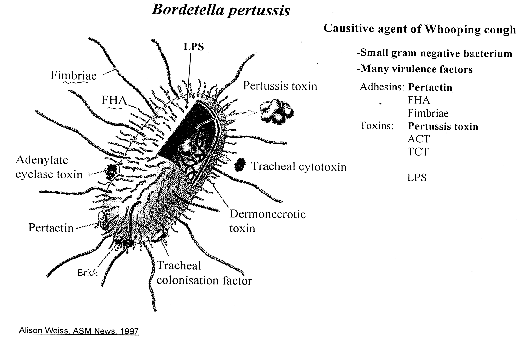Infection with Bordetella pertussis results in flu-like symptoms among humans, coupled with the characteristics “whoop” of the paroxysmal phase. Treatment of symptoms and bacterial colonization can be accomplished by antibiotic treatment and by vaccination.
Antibiotic treatment shows high effectiveness, with a number of drugs clearing one-hundred pecent of bacteria upon administration of a fourteen-day regimen (Tozzi et al. 2005). While erythromycin has been shown to clear all bacteria in just seven days, significant side effects make azithromycin an attractive method of clearing pertussis. Clarithomycin may also be used agaisnt B. pertussis infection (Tozzi et al. 2005). While controlled experiments have elicited no effective treatment role for antihistamines, diphenhydramine, corticosteroids, or salbutanol, intravenous pertussis immunoglobulin has been shown to decrease the paroxysmal whoop and bradycardia (Pillay and Swingler 2004, Tozzi et al. 2005). Antibiotic treatment is useful in developed nations where drugs are readily available, but it has drawbacks. The most obvious is that an individual must be diagnosed (and thus be symptomatic) before antibiotics will be utilized. Because B. pertussis survives only in humans, along with matters of cost effectiveness and infant mortality, pertussis treatment has focused on vaccination.
Whole cell vaccination of pertussis was developed in the 1950s (Todar 2004). The whooping cough vaccine, composed of killed and detoxified organisms, causes a TH1 response, similar to that described by natural infection by B. pertussis (Hoppe 1999, Mills 2001). Opsonizing antibodies, an outcome of TH1 help, facilitate intracellular killing of bacteria. Moreover, whole cell vaccination is characterized by an inflammatory response trafficked to the lungs, where lymphocytes, neutrophils, and macrophages infiltrate (Mills 2001). The whole cell vaccination insures rapid clearance of secondary infections with eighty to ninety percent efficacy (Hoppe 1999). A relatively high rate of reactogenicity associated with whole cell vaccination, leading to minor adverse effects (fever, local redness and swelling), has stimulated development of an effective acellular vaccine (Hoppe 1999, Mills 2001, Todar 2004).
The acellular whooping cough vaccine is better tolerated than whole cell vaccines, and seems to be significantly effective (Hoppe 1999). The vaccine is usually composed of various inactivated endotoxins of B. pertussis (Todar 2004). Usually two to five of the virulence factors PT, FHA, PRN, FIM2, and FIM3 are combined for effective treatment (Wood and Friedman). The acellular vaccine has been shown to induce a mixed TH1/ TH2 response, lacking the increase in neutrophil population within the lungs observed with whole cell vaccination (Mills et al 2001). While the acellular vaccination has been approved and is presently in use in America, it has been postulated that the use of adjuvants to polarize the acellular response towards TH1 may help prevent even mild disease from occuring (Mills 2001).
